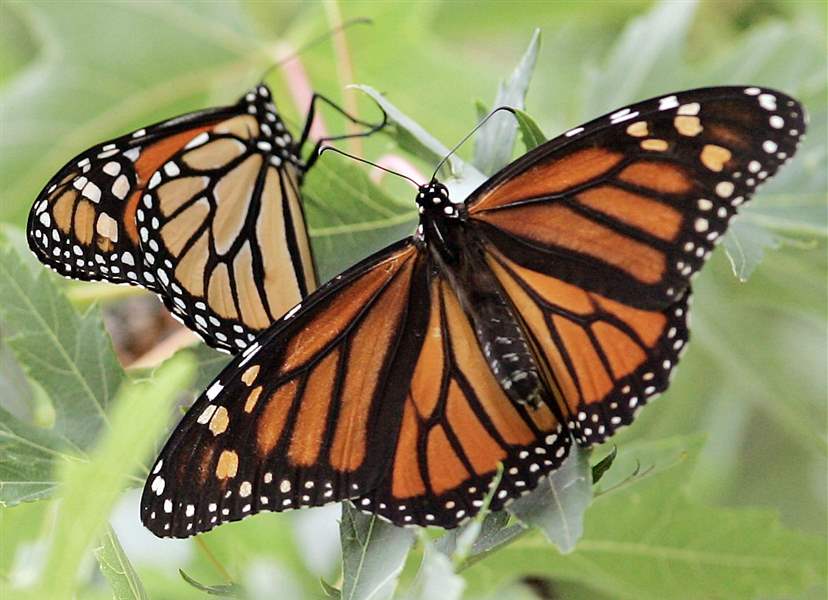
Programs invite public to help keep monarch butterflies on their throne
8/24/2010
To make it possible for monarch butterflies to like these to thrive in northwest Ohio and southeast Michigan, residents have created special habitats.
The Blade/Jeremy Wadsworth
Buy This Image
They're called "beleaguered beauties" for a reason.
Monarchs, those orange-and-black flit abouts, migrate by the hundreds of millions each fall, but the butterflies are threatened by habitat loss at their wintering sites and throughout the spring and summer breeding range.
Throughout the summer, naturalists and volunteers at Maumee Bay State Park have worked daily in a butterfly-rearing project at the Milton B. Trautman Nature Center, located near the Quilter Lodge, where a monarch festival will begin at noon Sept. 5.
Festival activities include the release of butterflies that will journey to wintering sites in the forests of Mexico.
Dana Bollin, naturalist at Maumee Bay State Park who has raised 12,000 monarchs since the butterfly program began there 18 years ago, will share information about the winged flutterbyes and elaborate on the details of conservation efforts, with festival-goers.

To make it possible for monarch butterflies to like these to thrive in northwest Ohio and southeast Michigan, residents have created special habitats.
During the monarch festival, Ms. Bollin will place butterflies on children's hands, one per child, during the release. Other activities will include face painting and cookie decorating. Ms. Bollin, using the recipe of her Grandmother Keil, will prepare ahead dozens of butterfly-shaped sugar cookies. She'll even concoct the frosting from scratch.
Ms. Bollin lives near Oak Harbor in Ottawa County now, but grew up in Toledo's South End.
Demonstrations are free, but a $3 wristband fee will be charged for participation in children's crafts.
Proceeds will be donated to the Monarch Butterfly Sanctuary Foundation, an organization dedicated to preservation of the monarch's overwintering location.
The foundation also funds research and educational projects to help the butterflies.
Monarch habitats are rapidly declining as a result of urban sprawl, roadsidemanagement practices, and increased use of herbicides that efficiently kill the milkweeds that butterflies once found in abundance in northwest Ohio and southeast Michigan.
On average, 500 to 600 butterflies are raised and released at Maumee Bay State Park each year, Ms. Bollin said. Between 75 and 100 of them will be released on Sept. 5.
As part of the state park's educational-and-research program, caterpillars and eggs are brought into a protected environment. Doing so eliminates the possibility of the insects being mown down, preyed upon, or parasitized, said Ms. Bollin, who said she considers monarchs as a "flagship insect."
"It's large. It's visible. It's apparent. It's bold and iconic and so if these really common, naturally occurring, abundant insects are in trouble, what is the hope for the rest of us?" Ms. Bollin said.
She tells people about the importance of weeds and brushy, messy areas that are not mowed, sprayed, or sterilized.
That way, she says, "you can have praying mantis, ladybugs, spiders, snakes, and butterflies."
Ms. Bollin added: "We don't exist on the planet in a vacuum. We hold ourselves above nature but we are connected. What befalls the lowest insects will befall the rest of us.
"I have people say 'where are the butterflies we used to see?' and I tell them they've pretty much been paved. What has not been paved, has been sprayed or mowed."
She encourages people to plant butterfly habitats and to protect their existing habitats, which means allowing weeds to flourish along fence lines or roads.
"I like weeds," Ms. Bollin said.
And monarchs like weeds too, namely milkweed, a plant critical for monarch egg-laying and caterpillar development.
Ms. Bollin serves a bushel or two of milkweed every day to keep the insects growing, she said. Milkweed is abundant at the state park, she said.
In the 11 years she has lived in Ottawa County, she said there's been a noticeable drop in the number of monarchs. "I can't believe how scarce they've become."
Chemicals sprayed on corn and soybean fields have eliminated a lot of milkweed, she said. The chemicals not only kill milkweed, but plants along farm fields and roads.
"I talk to dozens of people everyday about the importance of the project and the importance of milkweeds," Ms. Bollin said, and often people comment that they weren't aware of the milkweed and its monarch connection. She tells visitors to let corners of their yards go to weed. "I tell them to let milkweed grow."
At the Butterfly House, a monarch release is scheduled for 12:30 p.m. Sept. 25.
Hundreds of locally raised monarch butterflies will be released to begin their migration to Mexico, said Duke Wheeler of Wheeler Farms. There is no charge to attend the event. A short program will be presented about monarchs.
The Butterfly House will be open to the public on the monarch release day. Normal fees will apply for admission to the Butterfly House.
Last weekend, a monarch egg hunt was held at the Butterfly House.
People searched the farm for monarch eggs and were instructed on how to care for the eggs to help increase the monarch population.